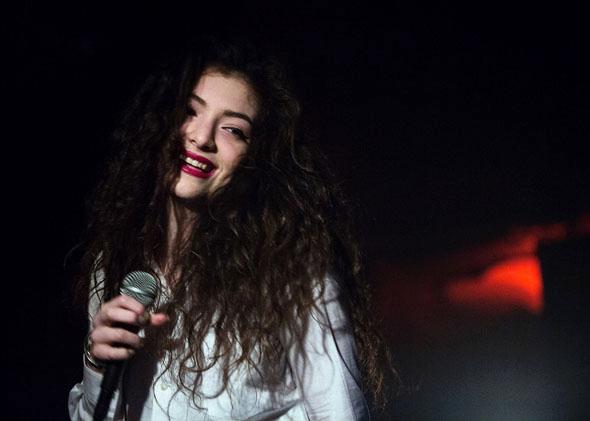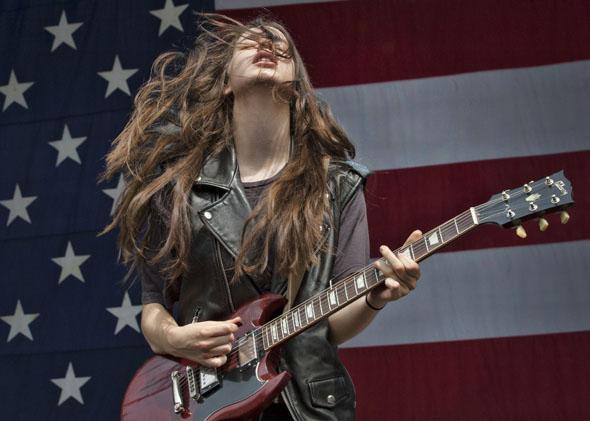By the end of the decade, will people look back at the fall of 2013 as the moment when the outlines of twenty-teens pop music began to solidify into a distinctive shape? It’s starting to feel that way. While the over-ballyhooed statement albums and songs of summer are already fading into footnotes, it’s the albums of autumn that have more to say about what music means now.
Last week’s coup by Drake’s Nothing Was the Same affirmed the staying power of the dear-diary introspective turn in male rap, filigreed with R&B elements, which the Times’ Jon Caramanica has called “Drakewave.” This week, by contrast, full-length debuts from antipodean teen songwriter Lorde and Los Angeles sister trio Haim present young white women drawing on multiple genres to forge voices as brash as any dance diva’s or swaggering MC’s. In the mirror play between the two trends we might be glimpsing a new chapter in pop cross-dressing, sexually and racially, or at least a fresh length of leash for the century of everything-goes.
These crossover girls aren’t making an iconoclastic assertion in the way Kesha asserted her prerogative to occupy the shock-value territory of male rappers a few years back. Instead they treat all sounds and stances as common property, as matter-of-factly as someone flipping through tracks and pictures on her smart phone and grabbing whatever grabs her. Some observers have called Haim’s music in particular a “mashup,” but that’s a passé, self-conscious 2000s term for what’s becoming standard procedure.
On Pure Heroine by Lorde, aka New Zealand-born 16-year-old Ella Yelich-O’Connor, the mixture is of a songwriter with the kind of literary sensibility one expects to come bearing an acoustic guitar (like the nearly as young British singer Laura Marling) working instead with slinky melodies, electronic beats, and danceable choruses. Fittingly, then, rather than offer nature imagery or meditations on the soul, Lorde’s lyrics engage with the consumerist myths that are thrust at young minds by music and media. Her breakout single “Royals”—an unexpected top 10 that also made her the first female soloist to reach No. 1 on the Billboard “alternative” chart since 1996 (the year she was born)—is a rebuttal to the materialistic boasts she heard listening to Jay-Z and Kanye West’s Watch the Throne: “Everybody’s like, Cristal, Maybach, diamonds on your timepiece,” she sings. “Jet planes, islands, tigers on a gold leash … / We don’t care, we’re not caught up in your love affair.”
Still, she’s also said that Kanye is one of her favorite artists—and the way she depicts the pressures and textures of teenage life in her songs is shot through with hip-hop images and cadences, even if she declares to club-land in “Team,” “I’m kinda over gettin’ told to throw my hands up in the air/ So there.” Lorde is happy to borrow the self-regarding stance she’s absorbed from rap records, but prefers to boast (in perfect precocious-teen form) about herself and her friends as the aristocrats of a realm scant on “lux” but rich in passion and imagination.
It’s not just the maturity of her tone that makes the New Zealander unlike any teen pop star of recent years. (She comes by the verbal dexterity naturally, as her mother is the respected New Zealand poet Sonja Yelich.) It’s also the musical space she’s claimed—while Miley Cyrus and Justin Bieber strain to assimilate completely to the dance-pop mainstream and Taylor Swift enters it with wariness, Lorde haughtily assumes a place that’s in that game but not of it.

Photo by Mat Hayward/Getty Images
Her ambivalence is not entirely unlike Drake’s, and she can fret about fame somewhat the way he does: “I’m little, but I’m coming for the crown,” she crows in “Still Sane,” then worries, “Only bad people live to see their likenesses set in stone/ What does that make me?” Yet where Drake tends to sound fatalistic about his enmeshment in boys-club decadence, Lorde’s hesitancies pale in comparison to her keenness to prove she can ascend with her integrity intact. It would be premature to read an “end of men” narrative into that contrast—Drake still has the lion’s share of swag and sway—but it seems telling that those male privileges of late seem ever more saddled with resentful insecurities.
Certainly Haim seems to be having way too good a time to trifle with such neuroses. These three San Fernando Valley Jewish sisters—bassist Este, guitarist Danielle, and keyboardist Alana Haim, pronounced hime, ages 27 to 21—grew up playing classic-rock covers with their parents in the endearingly dumbly named family band Rockinhaim while listening to 1990s R&B on the radio. The music they make now reaps the best of both, as tuneful as it is rhythm-obsessed—all three double on percussion, and they’re also backed by drummer Dash Hutton.
On stage (and in interviews) they charm with both virtuosity and goofiness. The time they’ve taken working on their first album Days Are Gone (delayed from the spring) has paid off in bear-trap-tight production values, with more than one-half of the 11 songs sounding like hits, though seldom of the same kind—Haim can come off as Joan Armatrading as produced by Madonna, Destiny’s Child covering Fleetwood Mac, Kate Bush remixed by Timbaland, or Anna Kendrick’s a capella choir from Pitch Perfect. There are also outbursts of global beats and harmonies courtesy of Este’s ethnomusicology degree, and guitar riffs from Danielle worthy of Prince and/or Pete Townshend (viz the semi-swipe in “Honey & I” from “Let My Love Open the Door”).
This jukebox effect isn’t incoherent—the variety is as sunnily generous as everything about Haim. But it wouldn’t have been altogether kosher a decade ago with the sorts of musicians the trio is prone to hang out with, such as Jenny Lewis (ex-Rilo Kiley) or Julian Casablancas (The Strokes).* At that time, few artists labeled “indie” would flirt with contemporary R&B—’80s electro, sure, but not more recent black-identified dance music. (One exception was The Blow, aka Portland performance artist Khaela Maricich, who coincidentally released her first album in six years this week, sounding still lively but a touch out-of-date.) Now those boundaries have weakened—credit it to playlist-shuffle listening culture, the more pop-friendly attitude among critics, the slow death of rock or even Obama-era shifts in race relations, as you please.
The harbingers of this shift included the hip-hop-minded Lana Del Rey and Amy Winehouse before her (you can hear each of their voices in Lorde’s), as well as the rise of Montreal arty synth-pop singer-composer Grimes in 2012, who went out of her way to proclaim (and demonstrate) her Mariah Carey influence. From the other side of the divide, there have been the genre-bending careers of Janelle Monae, Solange, and even Cee-Lo Green (who’s also employed Danielle Haim). As of this fall, all of these mavericks are looking more like the next main course.
It’s no accident that these paths are being broken primarily by young women: They’re making the case for the sounds that have always been their default domain. Dance-pop has been disdained for decades by rock dudes and jazz guys before them with sneers that this music “for girls” (or at best, with some forms of R&B, “for the ladies”) is manufactured pap, seldom meriting serious consideration. By blending dance-pop pleasures with an auteurist individualism that defies such condescension—as Sasha Frere-Jones recently wrote in The New Yorker, Haim “became everyone’s favorite band in America in roughly two weeks”—these younger artists are taking the sting out of that stigma, with luck for good.
Neither act is perfect. In fact each could learn from the other, as Pure Heroine suffers from getting stuck in a hazy midtempo zone in song after song, while the words on Days Are Gone are almost always unmemorable. But playing to your strengths is a better first-album strategy than attempting to be all things to everyone, and where they fall short I strongly suspect others of their generation will come along soon to fill in the gaps.
*Correction, Oct. 3, 2013: This article originally misidentified Jenny Lewis as Jenny Watson. (Return to the corrected sentence.)
